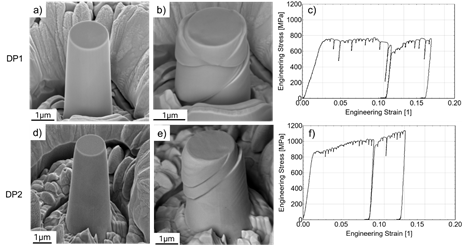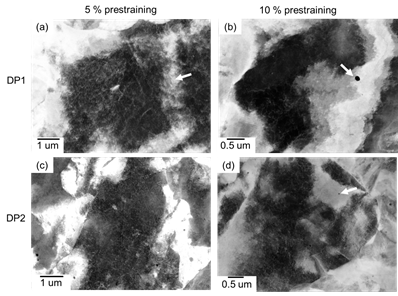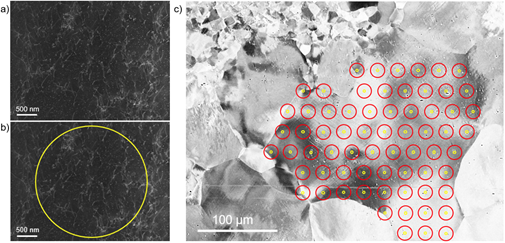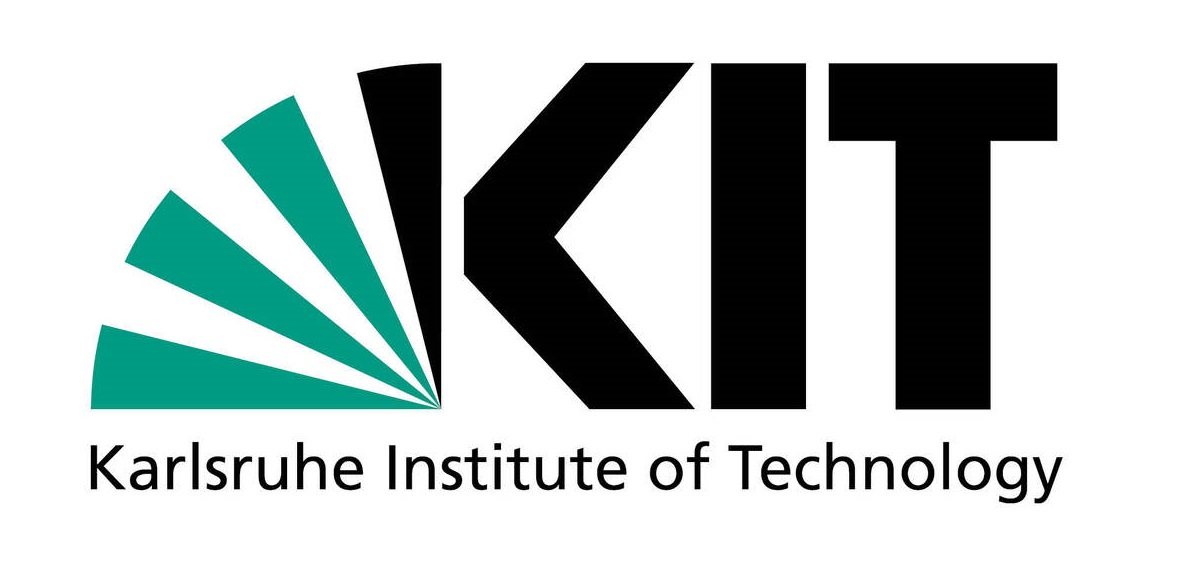Summary
Project B03 of the TRR 188 is dedicated to understanding the mechanisms of damage initiation and growth at the microscale. The 1st funding period (FP) focused on the investigation of mechanical properties of microstructure constituents of two DP800 steel grades using micropillar compression and micro fracture experiments. In the 2nd funding period, the strain hardening of ferrite was investigated in detail to understand whether or not strain hardening is responsible for the suppression of damage growth in DP steel grades. It was observed that one DP steel grade, named DP2, exhibited higher mechanical heterogeneity with soft ferrite and high strength martensite, resulting in more damage nucleation sites, while another DP steel grade, denoted as DP1, with strong ferrite and softer martensite showed fewer damage initiation sites. However, during subsequent deformation, the damage initiation sites in DP2 did not grow and remained small, while the few damage sites initiated in DP1 soon grew and resulted in final fracture. So far, besides the mechanical properties of all constituent phases, B03 was able to define an isotropic strain hardening model and soon will deliver a strain hardening model for latent hardening being vital input models for crystal plasticity-finite element method (CP-FEM) performed in the TRR 188. Also, in the 2nd FP the electrical resistance of samples with and without damage was investigated and used to calibrate and validate homogenization models to accelerate damage quantification at the macro scale.
In its 3rd FP, project B03 of the TRR 188 aims to provide quantitative insights into microstructure-level damage initiation and growth mechanisms. The project will address remaining challenges in validating representative elementary volumes (RVEs) of DP800, and will develop novel techniques for 3D characterization of aluminum alloys. By that, B03 will contribute to the TRR 188 themes for the 3rd FP via the generalization to new material classes, the 3D characterization, the identification and measurement of uncertainties as well as the role of void closure in damage annihilation.
The objectives of B03 for the 3rd funding period include:
- The experimental validation of damage behavior predicted by CP-FEM through focused ion beam (FIB)-based micromachining and 3D microstructure investigation for 1:1 comparison of experiments and models in RVEs.
- To gain a comprehensive understanding of damage initiation and growth mechanisms in Al6082 alloys using ex situ and in situ tensile testing in a nanoCT setup.
- To develop a protocol for the accelerated identification of the mechanical properties, i.e. of single grain stress vs strain behavior, of Al6082 based on diffraction contrast tomography (DCT).
- To separate the effect of crystal defects, i.e. dislocations, and damage, i.e. voids, on the electrical resistivity of Al6082 based on nanoCT combined with various heat treatments in a vacuum oven.
- To quantitatively investigate damage annihilation by void closure. This will be conducted on Al6010 using a nanoCT compression experiment on single voids.
Project B03's endeavors promise to enhance the mechanistic understanding of damage initiation and growth, provide unprecedented insights into the mechanical behavior at the length scale of individual grains as input parameter for modelling, provide guidelines for the optimization of materials microstructures, and by that, as an overarching goal, contribute valuable insights to TRR 188's research objectives.
Project progress to date
Damage initiation at the micro scale as investigated in the 1st FP and working hypothesis for 2nd FP
Project B03 focusses on damage initiation and damage growth mechanisms, and their quantitative understanding at the micrometer length scale. In the 1st FP, the mechanical heterogeneity in plasticity of ferrite and martensite of two DP800 grades was studied using in situ SEM micropillar compression. Although the two DP steel grades exhibit an identical macroscopic ultimate tensile strength, the individual phases showed totally different strength. Complementary, it was observed in project B02 via large scale SEM imaging that the higher heterogeneity in plasticity in DP2 leads to a larger number of martensite fractures (damage sites) while in DP1, high ferrite strength significantly reduces the number of martensite fractures. In the case of damage growth, however, the picture is the opposite: the softer the ferrite namely in DP2, the smaller the observed voids in deformed samples. Based on these observations the research question of the 2nd FP was formulated: Can soft ferrite suppress damage growth? If this is the case, is a pronounced strain hardening capability of soft ferrite locally the key parameter to suppress damage growth? To mechanistically address these questions, the definition of (i) an isotropic strain hardening model and (ii) a strain hardening model describing latent hardening based on small scale mechanical testing were key objectives of B03 in the 2nd FP.
Damage initiation in martensite islands
To allow for a quantitative microstructure modeling of damage initiation in projects B05 and C04, the fracture toughness of martensite islands was measured using micro cantilever fracture tests [Tia21]. The martensite islands exhibited a – compared to macroscopic fracture properties of DP800 – low fracture toughness of 10.1 ± 0.3 MPa m1/2. Nevertheless, it was concluded that the critical defect size is below the mean size of most martensite islands and consequently, damage preferentially occurs either in very large martensite islands or in banded martensite.
Results of 2nd FP: Isotropic strain hardening model of ferrite as input parameter for CP-FEM modelling
Based on the formulated research question from the first funding period, the main aim of the second funding period is to quantitatively understand the strain hardening behavior of ferrite embedded in DP800 and to cast it into a (i) isotropic strain hardening model of ferrite and a (ii) model being able to capture the latent hardening / softening in ferrite in order to quantitatively understand damage growth mechanisms under thermal activation and load path changes. Methods of choice are in situ SEM micropillar compression testing, macroscopic pre-straining experiments of DP800 as well as of polycrystalline ferrite with the same chemical composition as the ferrite in DP800, and dislocation analysis using electron channeling contrast imaging (ECCI).

Fig. 1. Representative micropillars in the as-milled state (a, d) and post-mortem from the pre-strained sample (b, e), together with the corresponding engineering stress-engineering strain curve (c, f). The first row (a-c) refers to 19.4% pre-strained DP1 while the second row (d-f) represents 21.6% pre-strained DP2.
In the first part of the 2nd FP, in situ SEM micropillar compression tests were performed on the ferrite of pre-strained DP800 samples to cast an isotropic strain hardening model of ferrite, which is now implemented in the CP-simulations of projects B05 and C04. Fig. 1 shows SEM images of the representative micropillars and their stress-strain curves with pre-strain levels of 19.4% and 21.6% for DP1 and DP2, respectively, from which the critical resolved shear stress (CRSS) was measured using the approach of Tian et al. [Tia20]. The cumulative distribution of CRSS shows that CRSS of ferrite increases significantly in both DP steel grades after pre-strain compared to the as-received state (Fig. 2 (a) and (b)). Interestingly, DP2 exhibits a much steeper slope suggesting higher strain hardening capacity in DP2 ferrite (Fig. 2(c)). Also, while the CRSS of DP2 is much lower than that of DP1 at 0% pre-strain, it becomes significantly larger at higher strain, which documents the pronounced strain hardening capability of the ferrite in DP2. Complementary machine-learning assisted analysis of damage site statistics in collaboration with project B02 indicated that DP2 has a significantly higher number of damage sites at low plastic strains. However, damage sites mostly remain small (below 5 µm2) upon further straining. This is in contrast to the damage site statistics in DP1, where a small number of damage sites at low strains rapidly grows to damage sizes larger 70 µm2. Consequently, based on pillar compression experiments on pre-strained DP800 and statistical analysis of the damage site evolution in two DP800 microstructures we could show that the larger strain hardening capacity of ferrite indeed suppresses the damage growth, leading to better ductility and formability of the DP2 steel.

Fig. 2. Cumulative distribution of the CRSS for (a) ferrite of DP1 in the as-received state and after 19.4% pre-straining; (b) Cumulative distribution of the CRSS ferrite of DP2 in the as-received state and after different pre-strains (maximum 21.6%). (c) The CRSS of ferrite plotted against the average shear strain converted from the global pre-strain of tensile specimens.
The origin of the different strain hardening rates of the two DP800 steel grades was investigated by analyzing the changes in dislocation structure upon deformation with ECCI. Both steel grades contain nanometer-sized nitride particles which can potentially contribute to strain hardening. However, the analytical calculation of their contribution using an Orowan strengthening model results in negligible strength contributions of below 1 MPa. Solid solution strengthening from alloying elements is identified as a further factor for strain hardening. As shown in Fig. 3, two DP steels exhibit different dislocation structure especially after deformation: DP1 shows a well-developed dislocation cell structure, meanwhile in DP2 dislocation cells are developed in lesser extend as individual dislocations are still visible inside the cells. The formation of such ordered dislocation substructures, such as dislocation walls and cells, can be delayed by the alloy dragging effect, which results in a high strain hardening rate in ferrite of DP2.

Fig. 3. Dislocation structures in ferrite grains of two DP800 steel grades resolved by ECCI. (a) 5 %; (b) 10% pre-strained DP1 and (c) 5%; (d) 10% pre-strained DP2. The arrows in (a) refers to a dislocation wall while in (b) and (d) are spotted dispersed particles.
In order to mechanistically understand the role of strain-path changes on the damage behavior of steels we investigated the latent hardening behavior of ferrite. To activate a small number of slip systems and control dislocation densities on them, a coarse grained microstructure is required, which is not possible to achieve in DP800 because of surrounding martensite grains. Therefore, single phase ferrite with the same composition of the ferrite in the two DP800 steel grades is used in the second part of 2nd FP, which was fabricated and prepared in collaboration with B01 (see Fig. 4).
To identify an anisotropic material model for latent hardening, the grain size in this model ferrite was set to >150 µm by annealing. Pre-straining of the model ferrite was used to produce regions with different dislocation densities and types (see Fig. 4). Typically, a gradient in dislocation density with less dislocations in grain interior and a higher dislocation density near grain boundaries was achieved. Examples of ECCI images in a single grain after 3% pre-straining are presented in Fig. 5 a and b. It is noteworthy that the micropillars under investigation were correlatively placed where ECCI images were captured – i.e. in the same region – offering a targeted analysis of the observed ferrite behavior (see Fig. 5 c). Consequently, the mechanical data is obtained in regions with known dislocation density. Several tenths of micropillars were then prepared in a single grain (see for instance Fig. 5 c) allowing statistical analysis of CRSS using the methods established in the 1st FP, however, at a known dislocation content. The CRSS was determined from the micropillar stress-strain curves, the grain orientation and the slip morphology of the micropillar [Tia24].
At the time of writing the application for the 3rd FP (January 2024), we are constantly increasing the statistics needed for identifying a meaningful material model for latent hardening. A high number of micropillars is needed to interpret changes in CRSS as function of dislocation density, dislocation type, crystallographic misorientation between forest dislocations produced during pre-straining and those activated during micropillar compression. This work package is ongoing and is aimed to be accomplished by the end of the 2nd FP.

Fig. 4. Determination of an anisotropic material model of latent strain hardening and strain softening, i.e. describing the CRSS depending on the dislocation densities on different slip systems. a) A large ferrite grain in a tensile specimen. In the center of the grain (A) single slip took place, near the grain boundary (B, C) multiple slip took place. The local dislocation density is measured by means of ECCI. b) Measurement of the critical resolved shear stress (CRSS) with dislocation density known from (a). Colored lines and ┴ represent dislocations. Dislocations of the same color signify that they possess an identical Burgers vector.

Fig. 5. a, b) ECCI images showing the dislocation structure after 3% pre-straining. c) Overview of a large pre-strained grain with 67 micro pillars milled into it. The yellow circles in (b) and (c) show the diameter of the micropillar that is micromachined (3 µm diameter) and subsequently tested in situ. The red circles (c) indicate the outer diameter of the trench around the micropillar (18 µm diameter).
Change of electrical resistance caused by damage
One branch of the TRR 188 is to develop efficient methods being able to characterize damage. Project B01 applies macroscopic tensile experiments with in situ resistivity measurements, which are combined with advanced electromechanically-coupled homogenization approaches. In order to understand the impact of various phases and interfaces as well as void nucleation and growth on the change in resistivity, project B03 provides complementary conductivity measurements at the micron scale. As a first step, artificial voids were produced via FIB (see example for a regular void pattern with circular voids in Fig. 6). The void arrays were varied in void size, void distance and void shape (circular vs. elliptical). Based on thin gold films as model system, the homogenization methods of B01 were successfully validated [Kai23]. Subsequently, the identification of conductivity of microstructural constituents was performed on steel samples. From the experiments conducted in the 2nd FP it is evident, that the two contributions to the sample`s resistivity, namely a change of crystal defects by plastic deformation and of damage (i.e. voids) cannot easily be separated using dual phase steel grades. A heat treatment being able to reduce the crystal defects (primarily dislocations and vacancies) to values close to the undeformed state results in significant microstructure changes in DP800 (grain coarsening, changes in carbon partitioning, etc.), which renders a mechanistic decoupling of parameters controlling the resistivity of damaged samples challenging. Consequently, based on the experience gained in the 2nd FP a work package decoupling crystal defects caused by deformation and damage is proposed for the 3rd FP.

Fig. 6. Experimental setup of B03 to calibrate and validate the electromechanically coupled FEM methods developed in B01 [Kai23]
Conclusion of Project B03 after 2 FP
The FIB-based toolbox comprising of micropillar compression and micro fracture testing established in the first funding period was successfully used to identify parameters being important for damage initiation and growth in DP steels. While a large mechanical heterogeneity – i.e. a contrast in ferrite and martensite strength – controls damage initiation, i.e. void formation, the strain hardening of ferrite is the parameter controlling damage growth. Based on two DP800 steel grades we showed that even a high number of damage initiation sites is not detrimental as long as the individual damage sites, i.e. voids, do not grow. In order to feed this quantitative knowledge into the process modeling of the TRR 188 consortium, an isotropic strain hardening model was developed in the 2nd FP, and a latent hardening model will be finalized within the 2nd FP. Based on both material models, damage at the microstructural scale can be predicted by cooperating CP-FEM projects. Furthermore, the dataset and quantitative insights of B03 provide the basis of future microstructure development, load path designs and the strain rate optimization of forming processes.
For DP800, a missing objective so far is a proper validation and optimization of CP-FEM models. While CP-FEM had been validated by macroscopic stress strain curves and the data of B03, e.g. together with B05, a detailed validation on volume elements resolving all microstructure details, i.e. an “representative volume element (RVE) with known grain structure and phase composition, is still lacking. Such 1:1 validations become vital as soon as questions regarding the minimum size of a RVE, the statistical behavior of RVEs, statistical uncertainties caused by RVEs as well as by microstructures are of concern or as soon as computationally less expensive material models (e.g. J2-plasticity instead of CP-FEM) should be applied. Consequently, a 1:1 validation of differently sized RVEs with known microstructure will be one objective in B03.
The generalization to different material classes will be another theme in the TRR188. Our FIB-based approach can be adopted to all material classes not being prone to extensive FIB damage at this scale. This comprises all steel grades, as we successfully demonstrated on bainitic steels (see [Gal23], [Jen23a] and [Jen23b]). However, due to the Gallium embrittlement of Al alloys, the FIB based approach used so far renders the approach of the 1st and 2nd FP impossible. Therefore, the generalization to other material systems requires the development of fast and efficient tools to measure the single grain behavior in a polycrystalline microstructure, which will be a second objective.
Significant challenges on separating damage and crystal defects in electrical resistivity measurements so far only allowed to accurately predict the damage content in model materials. To overcome this challenge, we will establish a protocol which can separate the void shape contributions and the crystal defect contributions to the electrical resistivity by highly resolved, 3D characterization of voids during deformation.
Project- and subject-related list of publications
[Rei12] Reischig, P.; King, A.; Nervo, L.; Vigano, N.; Guilhem, Y.; Palenstijn, W.; Batenburg, K.; Preuss, M.; Ludwig, W.: Advances in X-ray diffraction contrast tomography: flexibility in the setup geometry and application to multiphase materials. Journal of Applied Crystallography 46 (2013) 297-311. DOI: 10.1107/S0021889813002604.
[Rat13] Rathmayr, G.; Bachmaier, A.; Pippan, R.: Development of a New Testing Procedure for Performing Tensile Tests on Specimens with Sub-Millimetre Dimensions, Journal of Testing and Evaluation 41 (2013) 1–12. DOI: 10.1520/JTE20120175.
[Gue16] Gueninchault, N.; Proudhon, H.; Ludwig, W.: Nanox: a miniature mechanical stress rig designed for nearfield X-ray diffraction imaging techniques. J. Synchrotron Rad. 23 (2016) 1474-1483. DOI: 10.1107/S1600577516013850
[Deh18] Dehm, G.; Jaya, B.N.; Raghavan, R.; Kirchlechner, C.: Overview on micro- and nanomechanical testing: New insights in interface plasticity and fracture at small length scales. Acta Materialia 142 (2019) 248-282. https://doi.org/10.1016/j.actamat.2017.06.019.
[Tia20] Tian, C.; Ponge, D.; Christiansen, L.; Kirchlechner, C.: On the mechanical heterogeneity in dual phase grades: Activation of slip systems and deformation of martensite in DP800. Acta Materialia 183 (2020) 274–284. https://doi.org/10.1016/j.actamat.2019.11.002.
[Tia21] Tian, C.; Kirchlechner, C.: The fracture toughness of martensite islands in dual-phase DP800 steel. Journal of Materials Research 36 (2021) 2495-2504. https://doi.org/10.1557/s43578-021-00150-4.
[Tia21] Tian, C.; Dehm, G.; Kirchlechner, C.: Influence of strain rate on the activation of {110}, {112}, {123} slip in ferrite of DP800. Materialia 15 (2021) 100983. https://doi.org/10.1016/j.mtla.2020.100983.
[Kai21] Kaiser, T.; Cordill, M. J.; Kirchlechner, C.; Menzel, A.: Electrical and mechanical behaviour of metal thin films with deformation-induced cracks predicted by computational homogenisation. International Journal of Fracture 231 (2021) 223-242. https://doi.org/10.1007/s10704-021-00582-3.
[Kai23] Kaiser, T.; Dehm, G.; Kirchlechner, C.; Menzel, A.; Bishara, H.: Probing porosity in metals by electrical conductivity: Nanoscale experiments and multiscale simulations. European Journal of Mechanics A/Solids 97 (2023) 104777. https://doi.org/10.1016/j.euromechsol.2022.104777.
[Gal23] Gallardo-Basile, J.F.; Roters, F.; Jentner R. M.; Best, J.; Kirchlechner, C.; Srivastava, K.; Scholl, S.; Diehl, M.: Application of a nanoindentation-based approach for parameter identification to a crystal plasticity model for bcc metals. Materials Science and Engineering: A 881 (2023) 145373. https://doi.org/10.1016/j.msea.2023.145373.
[Jen23a] Jentner, R. M.; Tsai, S.P.; Welle, A.; Scholl, S.; Srivastava, K.; Best, J. P.; Kirchlechner, C.; Dehm, G.: Automated classification of granular bainite and polygonal ferrite by electron backscatter diffraction verified through local structural and mechanical analyses. Journal of materials research 38 (2023) 4177-4191. DOI: 10.1557/s43578-023-01113-7.
[Jen23b] Jentner, R. M.; Srivastava, K.; Scholl, S.; Gallardo-Basile, F.J.; Best, J. P.; Kirchlechner, C.; Dehm, G.: Unsupervised clustering of nanoindentation data for microstructural reconstruction: Challenges in phase discrimination. Materialia 28 (2023) 101750. https://doi.org/10.1016/j.mtla.2023.101750.
[Tia24] Tian, C.; Kusche, C.; Medina, A.; Lee, S.; Wollenweber, M. A.; Pippan, R.; Korte-Kerzel, S.; Kirchlechner, C.: Understanding the damage initiation and growth mechanisms of two DP800 dual phase grades. Materials & Design 238 (2024) 112630. https://doi.org/10.1016/j.matdes.2024.112630.







